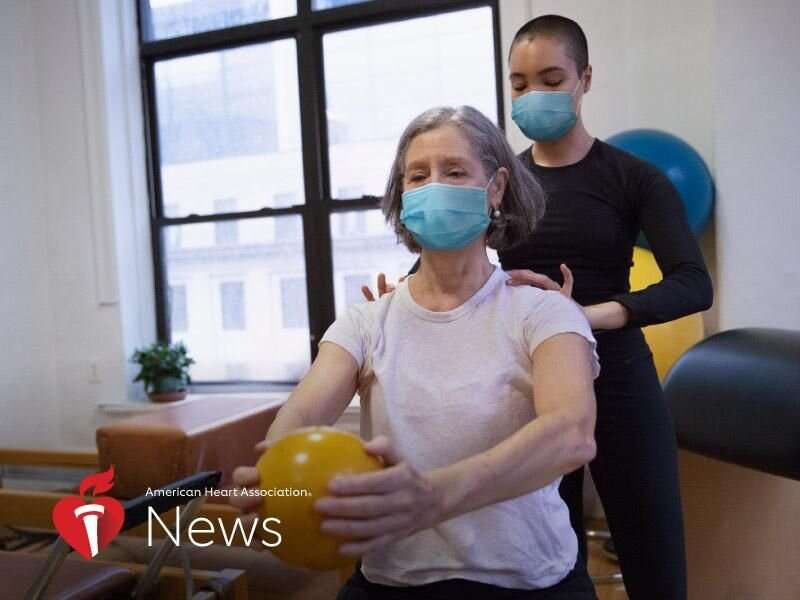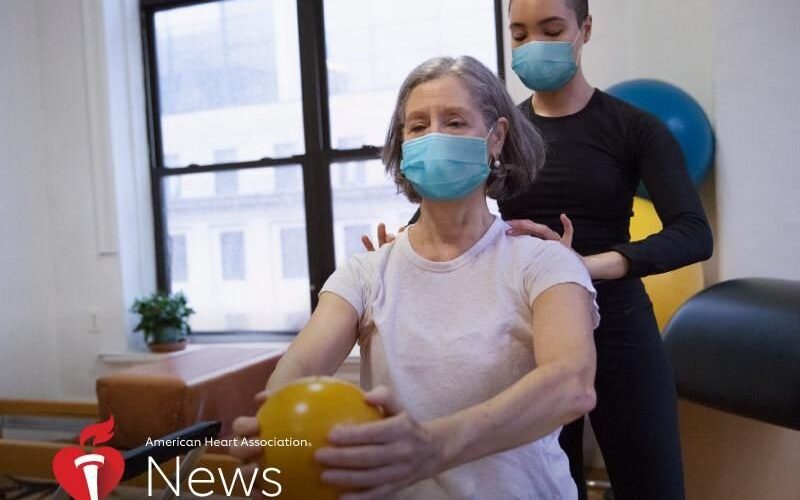Rehab for long COVID gives hope, while condition continues to puzzle

Caitlin Barber, a registered dietitian, was working at a Hudson Valley nursing home when the first wave of COVID-19 crashed over upstate New York in March 2020. She quickly fell ill, but wasn’t too concerned by her body aches, runny nose or inability to taste or smell.
A frequent runner who led a healthy lifestyle, Barber, then 27, expected a full recovery. After her two-week quarantine, she felt better and returned to work.
But days later her symptoms returned – along with new ones, far worse than the first. She suffered debilitating weakness and fatigue, fever, headaches, shortness of breath and brain fog so intense she couldn’t remember how to do her job. If she tried to walk, her heart rate soared, and her blood pressure dropped.
“I had three failed attempts at going back to work. I could only make it an hour at a time,” she said. “I became so debilitated that my husband had to carry me to the bathroom.”
Within months, Barber was in a wheelchair. She and her husband moved in with his parents for assistance. But local doctors could find nothing wrong. Finally, through an online support group for people whose symptoms persisted long past infection – a condition that came to be known as long COVID, or post-acute COVID-19 syndrome – she learned about Mount Sinai’s Center for Post-COVID Care in New York City.
Created in May 2020, the center is just one of dozens of such clinics that have sprung up around the nation, as the number of people struggling with post-COVID symptoms grows. Researchers estimate as many as 1 in 3 people infected with COVID-19 experience long COVID.
Doctors at Mount Sinai diagnosed Barber with long COVID POTS – postural orthostatic tachycardia syndrome. It’s a disorder affecting the autonomic nervous system characterized by chronic fatigue, dramatic heart rate increases and blood pressure dips upon standing. While researchers are still investigating how COVID-19 may trigger POTS, clinics like Mount Sinai are focused on getting them back on their feet.
Most of the clinic’s patients are struggling with POTS-like symptoms “similar to what you see in people who have spent long periods of time bed-bound and immobilized in the ICU,” said Dr. Ruwanthi Titano, a cardiologist for the Mount Sinai Health System. But few were actually hospitalized for COVID-19 and “most of them were really healthy prior to COVID.”
She treats them with high levels of hydration and compression stockings to improve blood pressure and circulation, along with breathing exercises and physical therapy to help them regain strength and stamina. Patients like Barber who find simple tasks exhausting are put on a graduated exercise program that starts with recumbent exercises, along with core and strength training to help the body reset and get used to moving again. Eventually, they build up to longer periods of upright movement with higher heart rate targets.
After six months, Barber said she was finally able to walk again but still experiences nausea, heart rate and blood pressure issues and a lack of appetite.
“I went there in September, and I was out of the wheelchair by March,” she said. “I’m now almost two years into this, and though I still struggle daily, I’m finally able to work again.”
Why this happens to people with long COVID is not well understood.
To create study populations large enough for more robust investigation, the National Institutes of Health invested $470 million into the Researching COVID to Enhance Recovery (RECOVER) initiative. It will support large-scale studies exploring COVID-19’s long-term impacts. In December, the American Heart Association launched an initiative to award $10 million in grants to researchers to study the long-term cardiovascular effects of COVID. Meanwhile, the World Health Organization has begun offering resources and support to help nations around the world develop rehabilitation programs for people struggling with long COVID.
One of the most basic challenges is how to diagnose or define long COVID. The Centers for Disease Control and Prevention characterizes it as a wide range of “new, recurring or ongoing symptoms and clinical findings four or more weeks after infection.” But there is no “hard and fast” definition, Titano said. What is clear, she said, is the sooner people seek treatment, the better their chances for recovery. (People who had or think they had COVID-19 should connect with their doctors to make sure exact infection times and symptoms are documented in their medical record.)
“Once you are out of acute illness, if you are still feeling symptoms a month out, you probably have long COVID,” she said. “If we treat it right away and get you into rehab, it may not develop into symptoms that last six months or a year. That’s when we really want to intervene, because that’s when we can make the greatest change in the course of the illness.”
What’s also become clearer to Titano is that the people she sees at Mount Sinai aren’t experiencing structural heart damage, even though they have shortness of breath, rapid heartbeats and blood pressure irregularities.
“Early on, I would order a whole gamut of tests to see what we were dealing with,” she said. “But most of those tests came back normal. What we find is the structure of the heart is unchanged, it’s the functionality we are trying to work on with rehab and physical therapy. Quality of life is lost, and that’s the biggest problem.”
Source: Read Full Article
